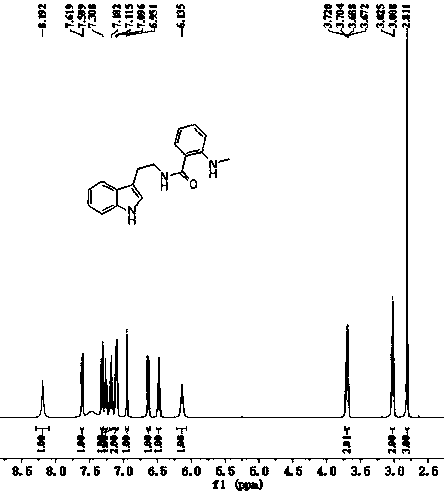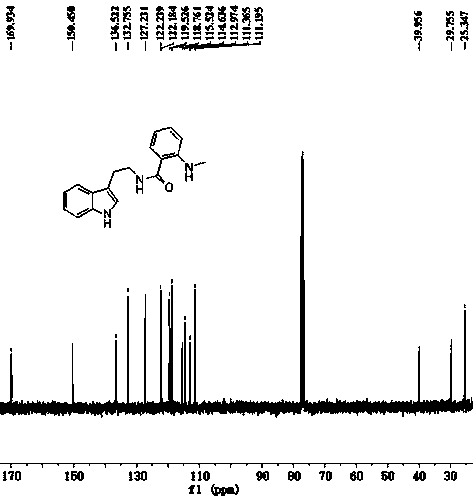Method for synthesizing evodiamine by carbonylation reaction three-step method
A technology of carbonylation reaction and evodiamine, which is applied in the fields of cell biology, clinical and medicine, can solve the problems of low reaction efficiency and cumbersome reaction steps, and achieve the effect of simple operation process, concise synthesis steps and mild reaction conditions
- Summary
- Abstract
- Description
- Claims
- Application Information
AI Technical Summary
Problems solved by technology
Method used
Image
Examples
Embodiment 1
[0021] (1) Add 0.2 mmol of N,N-dimethylaniline, 0.01 mmol of palladium chloride, 0.2 mmol of copper acetate into a 25 mL test tube, add toluene (PhMe) and N,N-dimethylformamide (DMF) 3 ml as a mixed solvent with a volume ratio of 10:1, covered with a balloon containing carbon monoxide and oxygen (volume ratio: 1:1) as a carbonyl source, and stirred at 100°C for 5 hours. After TLC (thin layer chromatography) detection, the reaction solution was cooled to room temperature, the balloon was removed, and the unreacted carbon monoxide and oxygen were slowly vented. The reaction solution was filtered, the filtrate was evaporated under reduced pressure to remove the solvent, and then separated and purified by column chromatography to obtain N-methyl isatoic anhydride with a yield of 27%.
[0022] (2) Add 1.0 mmol of N-methylisatoic anhydride and 1.0 mmol of tryptamine in a 25 mL round bottom flask, add acetonitrile as a reaction solvent, and stir for 8 hours at room temperature. TLC ...
Embodiment 2
[0035] (1) In a 25 mL test tube, add 0.2 mmol of N,N-dimethylaniline, 0.01 mmol of bistriphenylphosphine palladium dichloride, 0.2 mmol of copper acetate, add toluene (PhMe) and N,N -Dimethylformamide (DMF) 3ml was used as a mixed solvent with a volume ratio of 10:1, covered with a balloon containing carbon monoxide and oxygen (volume ratio: 1:1) as a carbonyl source, and stirred at 100°C. After TLC (thin layer chromatography) detection, the reaction solution was cooled to room temperature, the balloon was removed, and the unreacted carbon monoxide and oxygen were slowly vented. The reaction solution was filtered, and the filtrate was evaporated under reduced pressure to remove the solvent, and then separated and purified by column chromatography to obtain N-methyl isatoic anhydride with a yield of 49%.
[0036] Step (2) and step (3) are the same as embodiment 1.
Embodiment 3
[0038] (1) Add 0.2 mmol of N,N-dimethylaniline, 0.01 mmol of dichlorodiacetonitrile palladium, 0.2 mmol of copper acetate into a 25 mL test tube, add toluene (PhMe) and N,N-dimethyl 3 ml of formamide (DMF) was used as a mixed solvent with a volume ratio of 10:1, a balloon containing carbon monoxide and oxygen (volume ratio: 1:1) was used as a carbonyl source, and stirred at 100°C. After TLC (thin layer chromatography) detection, the reaction solution was cooled to room temperature, the balloon was removed, and the unreacted carbon monoxide and oxygen were slowly vented. The reaction solution was filtered, and the filtrate was evaporated under reduced pressure to remove the solvent, and then separated and purified by column chromatography to obtain N-methyl isatoic anhydride with a yield of 68%.
[0039] Step (2) and step (3) are the same as embodiment 1.
PUM
 Login to View More
Login to View More Abstract
Description
Claims
Application Information
 Login to View More
Login to View More - R&D
- Intellectual Property
- Life Sciences
- Materials
- Tech Scout
- Unparalleled Data Quality
- Higher Quality Content
- 60% Fewer Hallucinations
Browse by: Latest US Patents, China's latest patents, Technical Efficacy Thesaurus, Application Domain, Technology Topic, Popular Technical Reports.
© 2025 PatSnap. All rights reserved.Legal|Privacy policy|Modern Slavery Act Transparency Statement|Sitemap|About US| Contact US: help@patsnap.com



